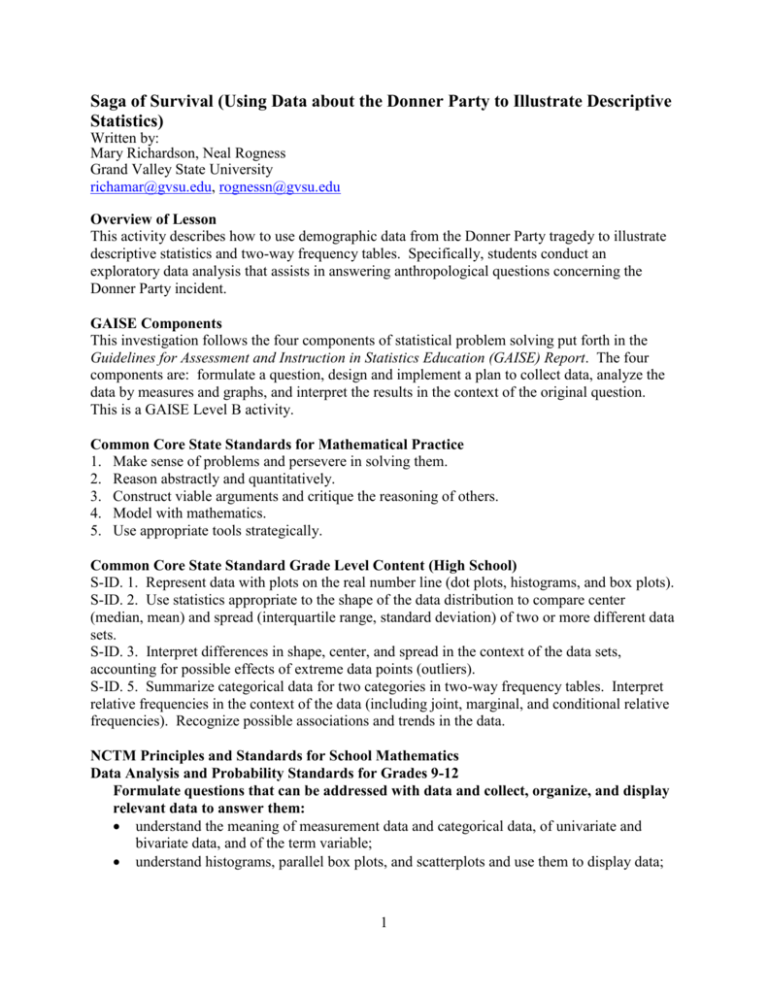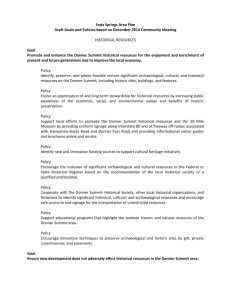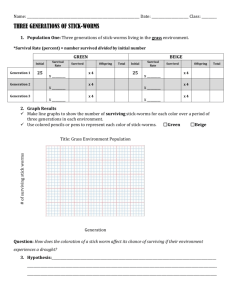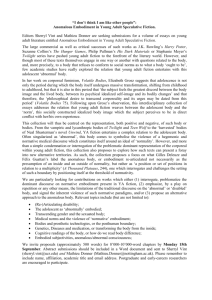Donner Party - American Statistical Association
advertisement

Saga of Survival (Using Data about the Donner Party to Illustrate Descriptive Statistics) Written by: Mary Richardson, Neal Rogness Grand Valley State University richamar@gvsu.edu, rognessn@gvsu.edu Overview of Lesson This activity describes how to use demographic data from the Donner Party tragedy to illustrate descriptive statistics and two-way frequency tables. Specifically, students conduct an exploratory data analysis that assists in answering anthropological questions concerning the Donner Party incident. GAISE Components This investigation follows the four components of statistical problem solving put forth in the Guidelines for Assessment and Instruction in Statistics Education (GAISE) Report. The four components are: formulate a question, design and implement a plan to collect data, analyze the data by measures and graphs, and interpret the results in the context of the original question. This is a GAISE Level B activity. Common Core State Standards for Mathematical Practice 1. Make sense of problems and persevere in solving them. 2. Reason abstractly and quantitatively. 3. Construct viable arguments and critique the reasoning of others. 4. Model with mathematics. 5. Use appropriate tools strategically. Common Core State Standard Grade Level Content (High School) S-ID. 1. Represent data with plots on the real number line (dot plots, histograms, and box plots). S-ID. 2. Use statistics appropriate to the shape of the data distribution to compare center (median, mean) and spread (interquartile range, standard deviation) of two or more different data sets. S-ID. 3. Interpret differences in shape, center, and spread in the context of the data sets, accounting for possible effects of extreme data points (outliers). S-ID. 5. Summarize categorical data for two categories in two-way frequency tables. Interpret relative frequencies in the context of the data (including joint, marginal, and conditional relative frequencies). Recognize possible associations and trends in the data. NCTM Principles and Standards for School Mathematics Data Analysis and Probability Standards for Grades 9-12 Formulate questions that can be addressed with data and collect, organize, and display relevant data to answer them: understand the meaning of measurement data and categorical data, of univariate and bivariate data, and of the term variable; understand histograms, parallel box plots, and scatterplots and use them to display data; 1 compute basic statistics and understand the distinction between a statistic and a parameter. Select and use appropriate statistical methods to analyze data: for univariate measurement data, be able to display the distribution, describe its shape, and select and calculate summary statistics; display and discuss bivariate data where at least one variable is categorical. Prerequisites Students will have knowledge of calculating numeric summaries for one variable (mean and five-number summary). Students will have knowledge of how to construct and interpret comparative boxplots. Students will have been introduced to two-way tables and conditional distributions. Learning Targets Students will have seen an exploration of real life data and how descriptive statistics can be used to answer contextual questions. Time Required A one hour class period if the lesson is completed interactively. The lesson could also be used as a homework assignment. Materials Required Graphing calculator or access to statistical software. Copy of the Activity Sheet (see pages 11 through 18). Instructional Lesson Plan The GAISE Statistical Problem-Solving Procedure I. Formulate Question(s) Ask students if they are familiar with the story of The Donner Party. Most should have some familiarity. Discuss some of the following historical background with them. The Donner Party is the name given to a group of emigrants who became trapped in the Sierra Nevadas during the winter of 1846 to 1847. Grayson (1990) powerfully notes: “The history of the Donner Party is so deeply embedded in American lore that there can be few Americans who do not know something about it. At its most lurid level, the fate of the Donner Party provides popular American history with a tale of cannibalism, of fellow travelers eating one another to survive. At a deeper level, the Donner history juxtaposes an attempt to fulfill a common midnineteenth-century American dream – a better life to be found by going west – with one of the worst tragedies to befall overland emigrants in their attempts to pursue that dream.” (p. 223) The final composition of the Donner Party was not established until August 1846, but the heart of the group, 22 members of the Donner and Reed families, left Springfield, Illinois, for 2 California in mid-April 1846. Several other families joined up with the Donners at Independence, Missouri, in May 1846. According to Grayson (1990), with the exception of the death of Margaret Reed’s elderly mother, Sarah Keyes, shortly after the journey had begun, the Donners and their traveling companions had a relatively uneventful trip as far as Fort Bridger on western Wyoming’s Green River. After reaching Fort Bridger on July 27, the Donner Party made a fateful decision to take a new and untested route to the Sacramento Valley. This new route had recently been touted by Lansford W. Hastings in a popular and influential guidebook. Had the Donner Party decided to stay on established trails, they would have headed north from Fort Bridger to southern Idaho’s Fort Hall. From there, they would follow the more-established California Trail. But, Grayson (1990) shares, “Hastings suggested that the emigrants should instead make their way south and west through the rugged Wasatch Range. Once in the valley of the Great Salt Lake, they were to pass south of the lake and then forge directly across the Great Salt Lake Desert to the headwaters of the Humboldt River. Here, on the Humboldt, they would then rejoin established paths. This more direct route, he asserted, would save both time and effort. It was this route, the Hastings Cutoff, that the Donner Party decided to follow.” (p. 224) The Donner Party followed Hastings’ route and then headed north to the upper Humboldt River. “Once at the Humboldt, they were back on what was to become the standard Central Overland Trail – down the Humboldt to the Humboldt Sink, then west to the Sierra Nevada, whose crossing provided the last great challenge to California-bound immigrants.” (Grayson, 1990, p. 228) But, two delays – one in the Wasatch Range and one as a result of crossing the Great Salt Lake Desert – had a fatal significance. “The Donner Party hit heavy late October snows in the eastern flanks of the Sierra Nevada. Unable to cross, they established camps near what is today called Donner Pass. By the time the last survivor was rescued, on April 21, 1847, 40 of the 87 members of the Donner Party had died. Of these 40, 35 died directly as a result of the forced winter encampment.” (Grayson, 1990, p. 228) Note: For an animated description of the Donner Party incident in the form of an online audio slideshow, the instructor can refer to the link: http://www.pbs.org/wgbh/nova/ancient/schablitsky-donner.html Julie Schablitsky, an archaeologist with the Museum of Natural and Cultural History at the University of Oregon has researched the Donner Party and created this audio slide show for PBS. Grayson’s (1990) demographic analysis of the pattern of deaths among the Donner Party showed that survivorship within the party was determined almost entirely by three factors: age, sex, and the size of the kin group with which each member traveled. In this section, we present some highlights from Grayson’s analysis. The table on the Activity Sheet gives a list of the names of members of the Donner Party, along with their gender, age, survival status, and family group size (Grayson 1990). According to Grayson (1990), “modern analyses of human mortality provide a number of expectations concerning the distribution of deaths within the Donner Party. The expectations are straightforward:” (p. 232) 3 “Analyses of age-specific mortality rates have shown that high death rates characterize both the youngest and oldest members of human societies…Mortality is generally very high between the ages of 1 and 5, after which it decreases. By the age of 35, mortality begins to increase again, becoming increasingly higher in older age classes.” (p. 232) These patterns lead to the expectation that mortality rates in the Donner Party should have been high for the youngest and oldest members of the group. “Analyses of the relationship between sex and mortality have routinely shown that for most populations, male mortality is greater than female mortality across age classes.” “On average, women are smaller than men, have a greater proportion of subcutaneous fat, and have a lower basal metabolic rate…Under cold stress, inactive adult males suffer greater core temperature reduction than inactive adult females…For these and other reasons,…adult women…should fare better under conditions marked by famine and extreme cold than their male counterparts…It is also possible that tasks requiring shortterm physical exertion, performed primarily by adult male members of the Donner Party, may have made those individuals even more vulnerable to cold and famine.” (p. 233) These facts lead to the expectation that, unless females were excluded from important resources by males, mortality among the Donner Party should have been higher for males than it was for females. “Analyses of the relationship between mortality and the degree to which individuals participate in social networks have routinely shown an inverse relationship between these two variables: those individuals with larger social networks have reduced mortality rates.” (p. 233) “Accordingly, mortality in the Donner Party should have been inversely scaled to the number of social contacts, and in particular to the degree of social connectivity as measured by the size of the available kin groups.” (p. 324) This information leads to the expectation that those persons with larger family sizes should have a lower mortality rate. II. Design and Implement a Plan to Collect the Data Since this lesson does not involve direct data collection, after discussing some background information provide students with a copy of the Activity Worksheet, which contains the data table. III. and IV. Analyze the Data and Interpret the Results Part I. Analysis of Quantitative Data. The first goal for students is to calculate measures of center and spread and construct comparative box plots in order to compare the ages of the survivors to the ages of those who perished. Table 1 and Table 2 display results for the descriptive calculations (generated using SPSS, Version 20). 4 Table 1. Mean, median, standard deviation, minimum and maximum values for the ages of survivors and non-survivors. Table 2. First quartile and third quartile for the ages of survivors and non-survivors. In Figure 1, we see comparative box plots for the ages of the survivors and non-survivors. 70 60 50 Age 40 30 20 10 0 Perished Survived Survival Status Figure 1. Comparative box plots for the ages of survivors vs. non-survivors. 5 Students are asked to use the results of their descriptive calculations to write a statement giving their opinion about whether or not the ages of Donner Party members had an effect on likelihood of survival. Notice that the mean and median ages for those who perished were 24.18 and 25 years, respectively. Compare these values to the mean and median ages for those who survived, which were 16.65 and 13.50 years, respectively. Thus, it seems that a typical survivor was younger than a typical person who perished. The standard deviation of those who perished was 19.18 years vs. a much smaller standard deviation of 11.11 years for those who survived (however, with younger ages, we would expect a smaller standard deviation). So, there was less variability in the ages of those who survived. Another way to view this would be to note that the very young and the very old were more likely to perish than to survive. Overall, the box plots show that those who survived tended to be younger than those who perished and that those who perished had more variation in age. The median age for survivors was much lower than for those who perished, and we can also see that the third quartile was much lower for those who survived, compared to those who perished. However, the first quartile for those who perished was lower than the first quartile for those who survived. In order to examine the relationship between age, gender, and likelihood of survival, students are asked to construct comparative box plots to display four age distributions: Female Survivors, Female Non-Survivors, Male Survivors, and Male Non-Survivors. In Figure 2, we see comparative box plots for the four age distributions. 70 60 50 Age 40 30 20 10 0 Male Survivors Male Non-Survivors Female Survivors Female Non-Survivors Survival Ages Within Gender Figure 2. Comparative box plots for the ages of survivors vs. non-survivors within gender. 6 Students state their opinions about whether or not the age/gender of a person had an effect on their likelihood of survival. From the comparative box plots, we can see that the Male NonSurvivors had the highest median age. The median ages of the Male Survivors, Female Survivors, and Female Non-Survivors are all relatively close. The ages of the Female Survivors had the least variability, whereas the ages of the Female Non-Survivors had the most variability. Part II. Analysis of Qualitative Data. The age of a Donner Party member is an example of a quantitative variable. However, there are also qualitative (or categorical) variables of interest to be analyzed, such as the gender of a Donner Party member and whether or not a member survived. Further, the age variable can be recoded into a variable that represents whether a member is an adult or a child. It is of interest to explore the relationship between these variables. On the Activity Sheet, we present a number of tables, both single-variable frequency tables and two-variable contingency tables, that summarize information about gender, mortality, and age (adult vs. child) of the Donner Party members. Students are asked to perform calculations on the tables to help answer the following questions: Was a Donner Party member’s likelihood of survival related to his/her gender? Was a Donner Party member’s likelihood of survival related to whether or not a person was an adult? Students complete the questions on the Activity Worksheet and see an illustration of the usefulness of two-way frequency tables for summarizing the relationship between two categorical variables. Constructing appropriate conditional distributions illustrates how to informally determine if two categorical variables are associated. Students calculate the overall percentage of deaths of the Donner Party members; 46% of the Donner Party members perished. Students then construct a two-way table to display the variables Gender and Survival Status: Mortality by Gender Died Survived Male 30 23 Female 10 24 Students calculate the percentage of deaths within each gender obtaining the conditional distribution of Survival Status given Gender: Mortality by Gender Died Survived Male 57% 43% Female 29% 71% Students use the conditional distribution to determine whether they believe that a Donner Party member’s likelihood of survival was related to his/her gender. As we can see from the 7 conditional distribution, the death rate was considerably higher for Males (57%) than for Females (29%), an indication that Gender and Survival Status are related. Students construct a two-way table to display the variables Age and Survival Status. Notes: 1. Physically and socially, girls mature earlier than boys. This fact is reflected in the age categories below, in which males are considered adults at age 21, females at age 18. 2. Individuals whose ages are unknown are included in the “Adult” category by default. Mortality by Age Group Died Survived Adults 25 20 Children 15 27 Students calculate the percentage of deaths within each age category obtaining the conditional distribution of Survival Status given Age: Mortality by Age Group Died Survived Adults 56% 44% Children 36% 64% Students use the conditional distribution to determine whether they believe that a Donner Party member’s likelihood of survival was related to his/her age. As we can see from the conditional distribution, the death rate was considerably higher for Adults (56%) than for Children (36%), so it appears that Age Category and Survival Status are related. Assessment 1. A question in the 2002 General Social Survey (GSS) conducted by the national Opinion Research Center asked participants how long they spend on e-mail each week. A summary of responses (hours) for 1881 respondents follows. (a) Explain how the summary statistics show us that at least 25% of the respondents said that they do not use e-mail. (b) What is the interval that contains the lower 50% of the responses? (c) What is the interval that contains the upper 50% of the responses? (d) Explain whether the maximum value, 70 hours, would be marked as an outlier on a boxplot. (e) Calculate Range/6 and compare the answer to the value of the standard deviation. What feature(s) of the data do you think causes the values to differ? 8 (f) Compare the mean to the median. What feature(s) of the data do you think causes the values to differ? 2. The figure below is a boxplot for comparing tip percentages for a male and a female restaurant server, each of whom drew happy faces on the checks of randomly selected dining parties. Discuss the ways in which the tip percentage distributions for the two servers differ. 3. Students in a class were asked whether they preferred an in-class or a take-home final exam and were then categorized as to whether or not they had received an A on the in-class midterm. Of the 25 A students, 10 preferred a take-home exam, while of the 50 non-A students, 30 preferred a take-home exam. (a) Display the data in a contingency table. (b) In the relationship between grade on the midterm and opinion about type of final, which variable is the response variable and which is the explanatory variable? (c) Determine an appropriate set of conditional percentages for determining whether there is a relationship between grade on the midterm and opinion about the type of final. Based on these percentages, does it appear that there is a relationship? Why or why not? Answers: 1. (a) The lower quartile Q1 = 0 hours. By definition, 25% of the values are at or below the lower quartile. (b) 0 to 2 hours (Minimum to Median). (c) 2 to 70 (Median to Maximum). (d) Yes, 70 hours would be marked as an outlier. The boundary defining an outlier on the high side is Q3 + 1.5×IQR = 5 + 1.5 (5-0) = 12.5 hours. (e) Range/6 = (70-0)/6 = 11.67.This is notably greater than the standard deviation. The outlier (70 hours) and skewness in the data cause Range/6 to differ from the standard deviation. (f) The mean is greater than the median. The outlier and skewness to the right causes this to occur. 2. Generally, females tended to have higher tip percentages. The median is clearly greater for females. The data for the females also shows greater spread than the data for the males. 9 3. (a) Prefer takehome Prefer in-class Total A on midterm 10 15 25 Not A on 30 20 50 midterm Total 40 35 75 (b) The response variable is preference for type of final exam. The explanatory variable is grade on the midterm. (c) Among students who got an A on the midterm, (10/25) 100% = 40% prefer a take-home final exam (and 60% prefer an in-class exam). Among students who did not get an A on the midterm, (30/50) 100% = 60% prefer a takehome final exam (and 40% prefer an in-class exam) There is relationship between the two variables. Students who did not get an A on the midterm are more likely to prefer a take-home final exam than are the students who got an A on the final. Possible Extension The data provided and used throughout this activity involve values for the variables of interest from the complete population (all known members of the Donner Party). As such, it would be inappropriate to consider inferential procedures that are commonly suggested as possible extensions with such activities. One possible extension that might be of interest would be to model survival status as a function of other variables, such as gender and age. In doing so, however, since the response variable is categorical, the technique of logistic regression is needed. This technique is typically beyond the set of techniques covered in classes taught by readers of this article. References 1. Grayson, Donald K. (1990), “Donner Party Deaths: A Demographic Assessment,” Journal of Anthropological Research, v.46, n.3. 2. Ramsey, F. and Schafer, D. (2002), The Statistical Sleuth: A Course in Methods of Data Analysis, 2nd edition, California: Duxbury. 3. Assessment questions from: Mind on Statistics, Third Edition by Utts/Heckard, 2006. Duxbury Press. 10 Saga of Survival Activity Sheet Background (Adapted from Ramsey and Schafer 2002) In April 1846 the Donner and Reed families left Springfield, Illinois, for California by covered wagon. In July, 1846, the Donner Party, as it became known, reached Fort Bridger, Wyoming. There, its leaders decided to attempt a new and untested route to the Sacramento Valley. Having reached its full size of 87 people and 20 wagons, the party was delayed by a difficult crossing of the Wasatch Range and again in the crossing of the desert west of the Great Salt Lake. The group became stranded in the eastern Sierra Nevada mountains when the region was hit by heavy snows in late October. By the time the last survivor was rescued in April, 1847, 40 of the 87 members had died from famine and exposure to extreme cold. The following table shows the names, sex, ages, and family group sizes of the survivors and nonsurvivors of the party. Donner Party Roster Name P=Perished Family S=Survived Group Size Sex Age Antonio Male 23 P 1 Breen, Edward Male 13 S 9 Breen, Isabella Female 1 S 9 Breen, James Male 4 S 9 Breen, John Male 14 S 9 Breen, Mary Female 40 S 9 Breen, Patrick Male 40 S 9 Breen, Patrick, Jr. Male 11 S 9 Breen, Peter Male 7 S 9 Breen, Simon Male 9 S 9 Burger, Charles Male 30 P 1 Denton, John Male 28 P 1 Dolan, Patrick Male 40 P 1 Donner, Elitha Female 14 S 16 Donner, Elizabeth Female 45 P 16 11 Donner, Eliza Female 3 S 16 Donner, Frances Female 6 S 16 Donner, George Male 62 P 16 Donner, George Male 9 S 16 Donner, Georgia Female 4 S 16 Donner, Isaac Male 5 P 16 Donner, Jacob Male 65 P 16 Donner, Leanna Female 12 S 16 Donner, Lewis Male 3 P 16 Donner, Mary Female 7 S 16 Donner, Samuel Male 4 P 16 Donner, Tamsen Female 45 P 16 Eddy, Eleanor Female 25 P 4 Male 3 P 4 Eddy, Margaret Female 1 P 4 Eddy, William Male 28 S 4 Elliott, Milton Male 28 P 1 Fosdick, Jay Male 23 P 12 Fosdick, Sarah Female 22 S 12 Foster, George Male 4 P 13 Female 23 S 13 Foster, William Male 28 S 13 Graves, Eleanor Female 15 S 12 Graves, Elizabeth Female 47 P 12 Graves, Elizabeth Female 1 S 12 Male 5 P 12 Eddy, James Foster, Sarah Graves, Franklin, Jr. 12 Graves, Franklin. Male 57 P 12 Graves, Jonathan Male 7 S 12 Graves, Lavina Female 13 S 12 Graves, Mary Female 20 S 12 Graves, Nancy Female 9 S 12 Graves, William Male 18 S 12 Halloran, Luke Male 25 P 1 Hardkoop, Mr. Male 60 P 1 Herron, William Male 25 S 1 Hook, Solomon Male 14 S 16 Hook, William Male 12 P 16 James, Noah Male 20 S 1 Female 3 P 4 Keseberg, Lewis Male 32 S 4 Keseberg, Lewis, Jr. Male 1 P 4 Keseberg, Philippine Female 32 S 4 McCutchen, Amanda Female 24 S 3 McCutchen, Harriet Female 1 P 3 McCutchen, William Male 30 S 3 Murphy, John Male 15 P 13 Murphy, Lavina Female 50 P 13 Murphy, Lemuel Male 12 P 13 Murphy, Mary Female 13 S 13 Murphy, Simon Male 10 S 13 Murphy, William Male 11 S 13 Female 1 P 13 Keseberg, Ada Pike, Catherine 13 Pike, Harriet Female 21 S 13 Pike, Naomi Female 3 S 13 Pike, William Male 25 P 13 Reed, James Male 46 S 6 Reed, James Jr. Male 5 S 6 Reed, Margret Female 32 S 6 Reed, Patty Female 8 S 6 Reed, Thomas Male 3 S 6 Reed, Virginia Female 12 S 6 Reinhardt, Joseph Male 30 P 1 Shoemaker, Samuel Male 25 P 1 Smith, James Male 25 P 1 Snyder, John Male 25 P 1 Spitzer, Augustus Male 30 P 1 Stanton, Charles Male 35 P 1 Trubode, J. B. Male 23 S 1 Williams, Baylis Male 24 P 2 Williams, Eliza Female 25 S 2 Wolfinger, Mr. Male ? P 2 Wolfinger, Mrs. Female ? S 2 14 Part I Instructions: Your goal is to answer the following question: Was a Donner Party member’s likelihood of survival related to his/her age? To help answer this question, complete the following. 1. Calculate descriptive statistics for the ages of the Donner Party members. Obtain the calculations separately for those who Perished and those who Survived. Perished Survived mean = __________ mean = __________ standard deviation = __________ standard deviation = __________ first quartile = __________ first quartile = __________ median = __________ median = __________ third quartile = __________ third quartile = __________ 2. Construct comparative box plots for the ages of those who Perished and those who Survived. 3. Write a statement, using complete sentences, giving your opinion about whether or not a person’s age had an effect on their likelihood of survival. You must refer to your descriptive statistics and your comparative box plots. Your statement must be thorough. 4. In order to examine the relationship between age, gender, and likelihood of survival, construct comparative box plots to display four age distributions: Female Survivors, Female NonSurvivors, Male Survivors, and Male Non-Survivors. Write a paragraph stating your opinion about whether or not a person’s age/gender had an effect on their likelihood of survival. You must refer to your comparative box plots. Your statement must be thorough. 15 Part II Instructions: Now, we want to examine the data in a different way. We would like to answer the questions: Was a Donner Party member’s likelihood of survival related to his/her gender? Was a Donner Party member’s likelihood of survival related to his/her age? Following are some two-way tables that compile The Donner Party data. Note: For this part use total numbers given here regardless of total numbers used in previous parts of this exercise. A. Gender Table 1. Donner Party Members by Gender Male Female 55 34 Table 2. Mortality by Gender Male Female Died 32 9 Survived 23 25 B. Age Notes: 1. Physically and socially, girls mature earlier than boys. This fact is reflected in the age categories below, in which males are considered adults at age 21, females at age 18. 2. Individuals whose ages are unknown are included in the "Adult" category by default. Table 3. Donner Party Members by Age Group Adults Children 44 45 Table 4. Mortality by Age Group Adults Children Died 27 14 Survived 17 31 16 C. Gender and Age Group Combined Table 5. Survived Adults Children Male 7 16 Female 10 15 Adults Children Male 22 10 Female 5 4 Table 6. Died Table 7. Mortality by Age Group and Gender (Combines information from preceding tables.) Adults Children Men Women Total Boys Girls Died 22 5 27 10 Survived 7 10 17 Total 29 15 44 Total Total Male Female Total 4 14 32 9 41 16 15 31 23 25 48 26 19 45 55 34 89 1. (a) Calculate the overall percentage of deaths: members died. _____________% of the Donner Party (b) Calculate the percentage of the overall deaths that were male and female: Male Female 17 2. Construct a two-way table to display the variables Gender and Survival Status: Mortality by Gender Died Survived Male Female 3. Calculate the percentage of deaths within each gender. You have calculated the conditional distribution of Survival Status given Gender. Mortality by Gender Died Survived Male Female 4. Do you think that a Donner Party member’s likelihood of survival was related to his/her gender? Explain. 5. Construct a two-way table to display the variables Age and Survival Status: Mortality by Age Group Died Survived Adults Children 6. Calculate the percentage of deaths within each age category. You have calculated the conditional distribution of Survival Status given Age. Mortality by Age Group Died Survived Adults Children 7. Do you think that a Donner Party member’s likelihood of survival was related to his/her age? Explain. 18







